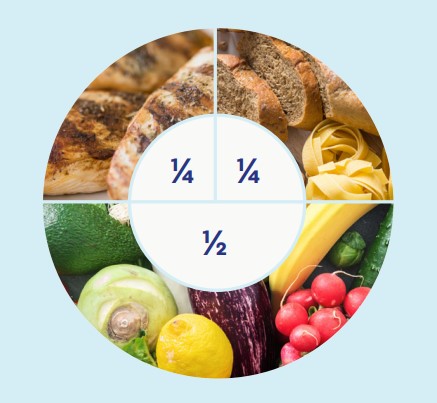Meal guide for healthy eating
Produced by:


Clinically reviewed by: Optum National Clinical Review Team
Meal guide for healthy eating
Making good food choices can help lower your cholesterol, blood sugar and weight.
Make your plate look like this:
 |
|
Breakfast ideas
|
|
|
|
|
|
Lunch or dinner ideas
|
|
|
|
|
|
Choose more foods from this section
|
Vegetables: 2 or more cups a day |
Fruits: 2 to 3 servings a day |
|---|---|
|
|
|
Legumes and soy: 4 to 5 servings a week |
Fish: 3 servings a week |
|---|---|
|
|
|
Healthy fats (Small portions) |
Unsalted nuts and seeds (Small portions) |
|---|---|
|
|
|
Carbohydrates |
Poultry and dairy |
|---|---|
|
|
|
Drinks |
|---|
|
Stay away from food in this section
|
Foods high in saturated fats |
|
|---|---|
|
|
|
Foods and drinks high in sugar |
|
|---|---|
|
|
|
Limit starches |
|
|---|---|
|
|
Heart-healthy diet guide: Mediterranean, DASH, and plant-based approaches for cardiovascular wellness
Learn about ways of eating that can support a healthy heart. Plus, tips for sticking to a heart-healthy eating pattern.
Read articleHealthy habits that can help maintain a good blood pressure
Your blood pressure can tell you a lot about your overall health. Here are ways to keep it in a healthy range. Plus, how to check your blood pressure at home.
Read articleHow diabetes affects your heart: Insights from Dr. Lindsey Mitrani
Dr. Lindsey Mitrani shares how diabetes can impact heart health, signs to watch for, and steps you can take to protect your heart during Diabetes Awareness Month.
Read article
Mammograms: What you need to know
In honor of Breast Cancer Awareness Month, we spoke with Dr. Shani Fruchter, a board-certified breast surgeon at Optum Medical Care, to break down everything you need to know about mammograms. From when to start screening to what the procedure feels like, this guide helps demystify one of the most important tools in breast cancer detection.
Read article